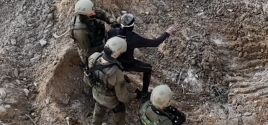Hundreds of fingers on the trigger: Every police officer on Merseyside could soon be equipped with a Taser stun gunDaily PostSep. 07, 2005 |
Popular 
"We Were There First and Foremost for Our Country of Israel," UNC Frat Bro Tells Fox News

BlackRock CEO: 'Xenophobic' Countries With Shrinking Populations May Be The 'Big Winners' in AI-Driven Future

House Passes 'Antisemitism Awareness Act' to Silence Criticism of Israel as Hate Speech

Video Shows Israeli Soldiers 'Using Palestinian as a Human Shield'

Report: Daily Wire Got Secret Gag Order Against Candace Owens 'While Publicly Negotiating a Debate'
 THEY have been a controversial addition to the armoury of the British police force but the people of Merseyside will have to get used to the sight of the electronic stun gun. Tasers have been operating on Merseyside for more than six months without alarm. Up to this point, though, the 50,000-volt weapons, which cause targets to lose muscle control and either freeze on the spot or collapse to the ground, have been available only to armed response units. But they comprise just a small proportion of the force and Chief Constable Bernard Hogan-Howe is now hoping for distribution to other officers, having become convinced of the worth of the Tasers. Mr Hogan-Howe said: "I think at the very least we need to spread the use of Tasers more widely than they are at the moment. "To have them available to all patrolling officers would be a very good option, and at the moment would appear to be a very safe option. "Though we have a significant number of firearms officers to respond to incidents, it would be more effective to have Tasers more widely available." The chief constable's view has been reinforced by the first few successful months of Taser use on Merseyside. While the weapon has not yet been fired in anger, on a number of occasions the very presence of the red sight dot on a violent offender has been enough to make him back down. Mr Hogan-Howe said: "I think what that shows is good evidence of the deterrent effect of Tasers and also the fact that officers have not been using them without due cause." The Taser has most recently hit the headlines when West Midlands police used it to capture a suspect following the aborted suicide bombings on London. Metropolitan Police Commissioner Sir Ian Blair was critical of the Taser's deployment in that instance as the electric charge of the Taser could have set off any explosives being carried by a bomber. But the question of a more widespread roll-out on Merseyside is likely to come down to the rather more mundane issue of finance. Budgets are already heavily stretched and each Taser costs in the region of £350. Mr Hogan-Howe said: "I think we'll have to talk to the Police Authority about it but, historically, they have been very good at providing us with the right equipment to do the job. "We may have to implement it a bit slower, perhaps in a staggered way. "That would allow the public to become more comfortable with Tasers while also giving us the time to train our officers in their use. "We may take a decision in principle to make them more widely available, leading eventually to every patrolling officer having one available." The chief constable's views were heartily endorsed last night by Ian Leyland, secretary of the Merseyside Police Federation, which represents rank and file officers in the region. The federation believes Tasers help with preventing violent crime, while providing greater protection for their officers. Mr Leyland said: "We are absolutely behind the Taser being deployed to many more front-line officers. "We're committed to providing the best protection for our officers, particularly with the number of assaults they face on the streets. "Tasers are also preventative - before an officer deploys it he has to shout the 'Taser, Taser' warning and the red sight dot appears on the target. "They can see they are in the sight and the consequence is that the majority of people will give up at that point and you don't have to go further than issuing the warning. "It has the potential to resolve problems and reduce assaults." Mr Leyland said he was not concerned that the deployment to other than armed response units would lead to the Taser being used on occasions when they were not totally necessary. He said: "I think we have to trust the professional judgement of police officers. "I remember similar arguments when we switched from wooden truncheons to side-arm batons, and when CS sprays were introduced. I don't believe there would be an increase in abuse - there is sufficient accountability and checks and balances in the system. "We would welcome any move towards Tasers being deployed to other front-line officers and would like to sit down with Bernard Hogan-Howe and work out how to fund it - that's always the key question." Mr Leyland said the unique circumstances of a police officer's job justified the extra protection the Taser gave officers. "People talk about sickness rates in the police force but it is down to 8.2 days a year. The average in the public sector is 6.8, and as for the private sector I can't think of many roles there where people go to work wearing body armour, CS spray and a baton, while enduring assaults at the rate of 40 a month. "It is a job where people need protecting. We expect our officers to show great bravery and we should equip them properly." So far the Taser sight has only ever been trained on an individual, including a violent incident on Liverpool's Bold Street, but never fired. Each time the person in question has backed down when challenged with it, backing up the prevention argument for the weapons. Tasers have become controversial following claims from Amnesty International they may have been responsible for more than 100 deaths in the USA. Taser International, which manufactures the stun guns, paints a different picture, saying that research by police in Columbus, Ohio, clearly showed that the stun guns had helped officers to avoid deadly force. In a statement Taser chief executive Rick Smith said: "The most gratifying statistic was the number of lives potentially saved." Shocks suspect with 50,000 volts TASER stun guns deliver a 50,000-volt shock to a suspect - causing them to lose muscle control and either freeze on the spot or collapse on the ground. The weapons fire needle-tipped darts up to 21ft to deliver the massive electric shock for five seconds, causing extreme pain to the person targeted. Rick Smith, co-founder of manufacturer Taser International, has described their effect as being like 1,000 pneumatic drills shaking every fibre of the body. Merseyside officers are using the American-made M26 Advanced Taser costing around £350 each. Current guidelines state they should only be used when the only viable alternative is conventional firearms. Guns condemned by Amnesty USE of Tasers in Britain is well behind America where the weapons are much more regularly discharged. But their use in the US has caused controversy with human rights group Amnesty International in particular expressing concern that Tasers are open to abuse - because they leave no mark - and can cause fatalities. A report from Amnesty in July 2005 said 130 people have died since 2001 after being 'Tasered' in the USA and Canada. However, in only 15 cases did coroners state the Taser played a role in the death. The American company which makes the Taser, Taser International Inc, was forced to spend heavily on lawyers to defend a series of costly lawsuits. However the company has never lost a court case in relation to a fatality. Amnesty believes Tasers are widely used in the USA as a standard policing tool rather than as an alternative to using firearms. The group believes Tasers should be used only by firearms officers. Amnesty International spokesman Steve Ballinger said: "To routinely arm the police with potentially lethal weapons that deliver 50,000 volts would be a highly dangerous step too far." |



